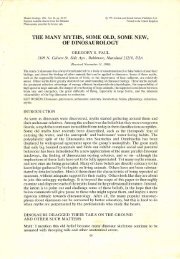HUNTERIA - Gregory S. Paul
HUNTERIA - Gregory S. Paul
HUNTERIA - Gregory S. Paul
Create successful ePaper yourself
Turn your PDF publications into a flip-book with our unique Google optimized e-Paper software.
plete (Table 1).Assuming a typical sauropod mass/femur length<br />
ratio it may have weighed over 50 tons. Lacking further data<br />
it is not possible to estimate the animal's total length. Another<br />
super-sized sauropod is the femur of the titanosaur Antarctosaurus<br />
giganteus (Huene, 1929; Van Valen, 1969;<br />
Table 1). It is in the same class as the biggest brachiosaur<br />
femora, but since the rest of the animal is poorly known, the<br />
best that can be said is that it was probably similar in mass<br />
too. The South African (Mclachlan and McMillan, 1976)and<br />
Laotian (Hoffet, 1942)femora Anderson et a1.(1985)cited are<br />
not from uniquely large individuals (Table 1).<br />
In the final analysis, B. (G.) brancai and B. (B.) altithorax<br />
were about as big as any other known sauropods. Just<br />
as importantly, B. (G.) brancai holds the record for the<br />
biggest species for which all of the skeleton is known. It was<br />
also the tallest, but not the longest. The largest known<br />
sauropods appear to cluster around 50 tons in lean condition,<br />
perhaps a third more in prime fat-bearing condition. This<br />
should not be taken as an ultimate limit. The sample of all<br />
known sauropods is a tiny fraction of the sampled populations<br />
available for many single species of living animals. Even<br />
larger sauropods certainly await discovery, and it is improbable<br />
that the largest were preserved in the fossil record. It is interesting<br />
that, in living tetrapods, extremely rare "world record"<br />
individuals are often twice as massive as average individuals<br />
(McWhirter and McWhirter, 1986).In this view sauropods of<br />
Aitken, W.G. 1961. Post Karroo. In: Quennell, -AM.,<br />
McKinlay, AC.M. and Aitken, W.G. (eds.). Summary of<br />
the geology of Tanganyika. Geological Survey of<br />
Tanganyika, Memoir 1. p. 153-256.<br />
Alexander, R.McN. 1985. Mechanics of posture and gait of<br />
some large dinosaurs. Zoological Journal Linnean Society<br />
83: 1-25.<br />
Anderson, J.F., Hall-Martin, A and Russell, D.A 1985.Longbone<br />
circumference and weight in mammals, birds and<br />
dinosaurs. Journal of Zoology 207:53-61.<br />
. Arkell, W.j. 1956.Jurassic Geology of the World. London:<br />
Oliver & Boyd Ltd.<br />
Bakker, R.T. 1971a. Dinosaur physiology and the origin of<br />
mammals. Evolution 25:636-658.<br />
Bakker, R.T. 1971b. Ecology of the brontosaurs. Nature<br />
229:172-174.<br />
Bakker, R.T. 1971c.Brontosaurs. In: McGraw Hill Yearbook<br />
of Science and Technology. New York: McGraw Hill. p.<br />
179-181.<br />
Bakker, R.T. 1974.Dinosaur bioenergetics: A reply to Bennett<br />
and Dalzell, and Feduccia. Evolution 28:497-502.<br />
Bakker, R.T. 1975.Dinosaur renaissance. Scientific American<br />
232 (4):58-78.<br />
Bakker, R.T. 1978. Dinosaur feeding behavior and the origin<br />
of flowering plants. Nature 248:168-172.<br />
Bennett, AF. and Dalzell, B. 1973. Dinosaur physiology: a<br />
critique. Evolution 27:170-174.<br />
Bird, R.T. 1985. Bones for Barnum Brown. Fort Worth:<br />
Texas Christian University Press.<br />
<strong>HUNTERIA</strong> VOL. U, no. 3, pp. 12, February 19, 1988<br />
GREGORY S. PAUL<br />
CITED REFERENCES<br />
100tons are not unrealistic, especially if bearing large amounts<br />
of seasonal fat.<br />
In comparison, Balaenoptera musculus typically weighs<br />
80-100 tons, and may reach 200 in feeding season (Ellis, 1980;<br />
McWhirter and McWhirter, 1986). Unfortunately there has<br />
never been a rigorous study of the mass of baluchitheres and<br />
the largest fossil proboscideans, which may rival each other<br />
as the biggest of terrestrial mammals. The baluchitheres and<br />
bigger mammoths appear to be rather gracile, and may not<br />
have been as massive as sometimes suggested. At perhaps 20<br />
tons or less, they certainly do not match the bigger sauropods<br />
in size. As for the greatest living land animal,Loxodonta<br />
africana bulls average 5 tons, often reach 7.5, and rarely reach<br />
about 10+ (Laws et al., 1975; McWhirter and McWhirter,<br />
1986).<br />
ACKNOWLEDGEMENTS<br />
Special thanks go to J. McIntosh and his bottomless store of Information<br />
on giant Mesozoic monsters. R. Bakker's many discussions on dinosaur<br />
anatomy were critical to this paper, as was his request that I prepare it.<br />
F. Boothman has provided important information and enjoyable discussion<br />
on the problem of big dinosaurs. K. Carpenter, M. Brett-Surman,<br />
D. Berman, D. Russell, R. Molnar, Dong Z., P: Currie and D. Gasparini<br />
have provided much helpful information and discussion on sauropods. Many<br />
thanks to H. Jaeger for his hospitality during my visit to the HMN. P. Sites<br />
helped reproduce the figures.<br />
Carrington, R. 1959. Elephants. New York: Basic Books.<br />
Colbert, E.H. 1962. The weights of dinosaurs. American<br />
Museum Novitates 2076:1-16.<br />
Cooper, M.R. 1984. A reassessment of Vulcanodon karibaensis<br />
Raath (Dinosauria: Saurischia) and the origin of<br />
the sauropods. Paleontologica Africana 25:203-231.<br />
Demmont, M.W. arid Soest, P.J. 1985. A nutritional explanation<br />
for body-size patterns of ruminant and nonruminant<br />
herbivores. American Naturalist 125:641-672.<br />
Dimery, N.j., Alexander, R.McN. and Deyst, K.A 1985.<br />
Mechanics of the ligamentum nuchae of some artiodactyls .<br />
Journal of Zoology 206:341-351.<br />
Dodson, P., Behrensmeyer, A.K., Bakker, R.T. and Mcintosh,<br />
J.H. 1980. Taphonomy and paleoecology of the dinosaur<br />
beds of the Jurassic Morrison Formation. Paleobiology<br />
6:208-232.<br />
Dutuit, J-M. and Ouazzou, A. 1980. Decouverte d'une piste<br />
de dinosaures sauropodes sur Ie site d'empreintes de<br />
Demnate (Haut-Arlas marocain). Memoirs Societe<br />
Geologie Francais 59 (139):95-102<br />
Ellis, R. 1980.The Book of Whales. New York: Alfred A<br />
Knopf.<br />
Eltringham, S.K. 1982. Elephants. Denver: Blanford Press.<br />
Fraas, E. 1908. Ostaftikanische Dinosaurier. Palaeontographica<br />
55:105-144.<br />
Galton, P.M. 1977. The ornithopod dinosaur Dryosaurus<br />
and a Laurasia-Gondwanaland connection in the Upper<br />
Jurassic. Nature 268:230-232.<br />
.:.









